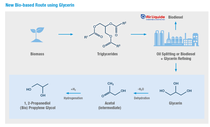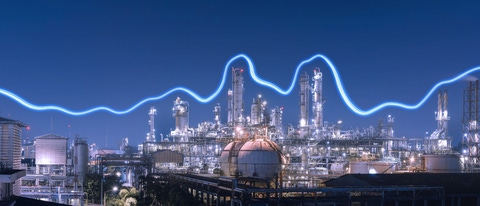Hydrogenation Catalysts
Sustainable solutions in our hydrogenation portfolio
In our portfolio of hydrogenation catalysts, we offer various solutions to help our customers achieve their climate protection goals.
Methanol to DME
The dehydration of methanol to DME is an integral part of several important syngas-based routes towards olefins and engine fuels.
BASF has developed in-depth experience on this application and is able to offer a state-of-the-art alumina catalyst portfolio including an advanced trilobe shape.
Our customers benefit from the high activity at low temperature with conversion level close to equilibrium and selectivity towards DME above 99%. Benefits for our customers with Al 3992 E are as following:
-
Broader operating window and flexible adjusting process parameter
-
Conversion close to equilibrium and selectivity towards DME above 99%
-
Energy saving due to high activity at low temperature
-
Cost saving due to lower bulk density and longer lifetime
Ethanol to Ethylene (E2E)
The ethanol to ethylene process (E2E) represents an attractive option to enter the diverse ethylene value chains based on alternative feedstocks. BASF has developed in-depth experience on this application and is able to offer a state-of-the-art alumina catalyst portfolio for the steam-assisted dehydration of different ethanol grades. Our customers benefit from the best possible raw material utilization with both conversion level and selectivity towards ethylene above 99% regularly demonstrated on industrial scale.
The BASF selection of alumina catalysts is characterized by ultrahigh alumina purity in combination with enhanced porosity. Our industry benchmark offerings each combine various strongly acidic catalysts with an individual material profile. Straight, ring-shaped and trilobe extrudates are recommended for this application. In addition, BASF operates dedicated pilot plants to replicate real-world operating parameters and deliver recommendations for efficient catalyst operation. In addition, we apply latest-generation computing tools to optimize processes and production plants in order to achieve unprecedented performance for our customers.

Glycerin to 1,2-Propanediol (MPG)
Looking for options to upgrade your glycerin business? Do you want to improve your value chain carbon footprint and develop into a bio refinery?
The oversupply of glycerin derived from production of biodiesel or fatty alcohols resulted in significant decrease of prices and made glycerin a low-price commodity limiting the outlets and margins for glycerin producers. Bio propylene glycol as a new outlet for glycerin is an attractive bulk chemical in a fast-growing market and offers multiple benefits to producers and has applications in many different industries, such as urethanes, polyester resins, food and beverage processing and deicing/antifreeze agent.
Bio propylene glycol represents an attractive alternative to conventionally produced propylene glycol from glycerin which does not rely on petroleum as raw material and offers an environmental advantage.
BASF teamed-up with Air Liquide Engineering & Construction, a market leader providing superior technology solutions for the world’s oleochemicals producers, to license the commercially proven BASF technology for hydrogenolysis of glycerol to bio propylene glycol. Glycerin is hydrogenated at very high conversion and selectivity in liquid phase with a proprietary BASF copper catalyst. The conversion to bio propylene glycol is taking place in two serial fixed bed reactors and at temperatures between 175 to 195 °C and at a pressure of 75 or 200 bar. The crude product is then further purified downstream in a two-column distillation to produce propylene glycol with a technical grade of more than 99.5% purity. Pharma grade bio propylene glycol is possible to produce depending on feedstock quality.
The technology for production of bio propylene glycol is commercially proven and successfully operating since 2012.

Glycerin to Propanol
Eni and BASF launched joint R&D initiative to reduce the CO2 footprint of the transportation sector.
- Both companies collaborate to develop sustainable technology to produce bio-propanol from industrial residues
- Innovative technology focuses on making use of a by-product of bio-diesel production
- Novel process to produce advanced, bio-based propanol
Eni and BASF have signed a strategic agreement on a joint R&D initiative to reduce the CO2 footprint of the transportation sector. The cooperation aims to develop a new technology to produce advanced bio-propanol from glycerin, a side stream of the production of industrial biodiesel (FAME, fatty acid methyl ester), that Eni will purchase from European producers. The technology under development involves the conversion of glycerin to propanol via an innovative, catalytic hydrotreatment process. The new approach consists of a process of applying a high-pressure hydrogenation reaction over a BASF catalyst, ensuring that the bio-propanol is produced with a high yield and purity while minimizing by-products. The bio propanol offers the potential to reduce greenhouse gas emissions by 65% to 75% compared to fossil fuels. Propanol obtained via this innovative method can be easily added as a drop-in bio fuel component to gasoline. Thanks to its better physicochemical properties compared to bioethanol and its very high-octane number, bio propanol is a valuable component for the preparation of premium gasoline.
C3/C4 Alcohol Dehydration to Propylene/Butene
The C3/C4 alcohol dehydration to olefin process represents an attractive option to enter the diverse C3/C4 value chains based on bio-feedstocks.
BASF supplies alumina catalyst which have proven their performance for many years on industrial scale.
Our customers benefit from the high catalytic performance with good tolerance towards water levels contained in the alcohol feedstock.
Bio-Butanediol (Bio-BDO)
1,4 Butanediol (BDO) is a low viscosity glycol used as an intermediate i.e., for the production of polymers and is typically produced via an energy intensive petrochemical route starting from acetylene and formaldehyde.
Biomass-derived succinic acid can be used as an alternative entry point into this value chain. The commercially available technology is based on the esterification of bio-succinic acid with methanol, followed by hydrogenation of the resulting ester, and the consequent co-production of BDO, tetrahydrofuran (THF) and γ-butyrolactone (GBL).
Glucose to Sorbitol
Sorbitol is a sugar polyol extensively used in nutrition, cosmetics, and medical or industrial applications. Sorbitol can be produced from glucose hydrogenation in the presence of noble metals and nickel catalysts.
BASF offers a broad portfolio of precious metal and nickel catalysts. Of particular importance is BASF’s heterogeneous catalyst for the conversion of glucose to sorbitol.
Features of BASF‘s catalysts include:
-
Excellent conversion and selectivity for the production of sorbitol
-
Continuous hydrogenation with no metal leaching
-
Less by-product formation for easier work-up
Furfuryl Alcohol
Hydrogenation of Furfural to Furfuryl alcohol
Furfural has been identified as one of the most promising chemical platforms directly derived from biomass and the technology for its production is already largely established.
The selective hydrogenation of furfural to furfuryl alcohol is a commercially established process that occurs either liquid or gas phase technologies.
Methyl Furan
2-Methylfuran (2MF) Hydration of Furfural with Cu 0203 T catalyst
BASF’s Cu 0203 T catalyst is the catalyst of choice for conversion of furfural to 2MF. It distinguished by its excellent selectivity for 2MF formation, high mechanical resistance and resistance to multiple regeneration cycles. It is easy to work with in terms of activation-reoxidation-regeneration-reactivation with no significant exotherms during these operations, thus has less probability to catch fire. Also, the copper catalyst E 415T, a Cr-free alternative is available.
Ethyl acetate
Dehydrogenation of (bio-)ethanol to ethyl acetate
In the recent years, the interest in the ethanol production from renewable natural sources has strongly grown in the world. The low-cost ethanol availability has also favored the production of different chemicals starting from ethanol as raw material.
The dehydrogenation of (bio-)ethanol provides a sustainable and commercially competitive access ethyl acetate.
BASF offers new Cr-free catalysts with successful commercial track record and unprecedented catalytic performance supporting customer’s transition into commercially attractive and more sustainable value chains.
